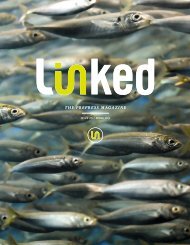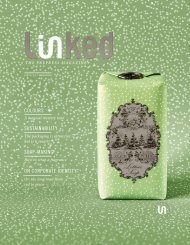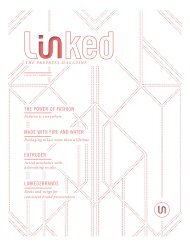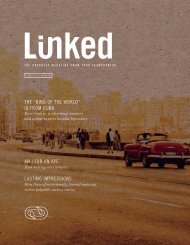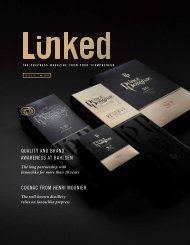Janoschka magazine Linked_V6_2021
You also want an ePaper? Increase the reach of your titles
YUMPU automatically turns print PDFs into web optimized ePapers that Google loves.
24 i n s i g h t s
issue #6 ©
l i n k e d
25
Multiple forms
for multiple functions
Another well-known tube is the one containing
Pringles crisps that was patented in 1970. Not
only is it highly original, it is also highly functional
because the crisps are safely stacked inside the
sturdy cardboard tube and do not get crushed.
The plastic lid can also be closed again, keeping
the crisps fresh longer.
Smarties are another colourful sweet treat. They were
invented by British confectioner Henry Isaac Rowntree
and were first produced in 1937. They, too, conquered
the western European markets (and sweet teeth)
during the sixties. Smarties have always stood out due
to their unusual packaging: a cardboard tube printed all
over with coloured chocolate drops.
SEE ARTICLE ON PAGE – SEE ARTICLE ON PAGE –
p.66
Smarties is a brand with cult status whose recognition
value is inextricably linked to its packaging. Nevertheless,
Nestlé took a daring step in 2021, switching the international
packaging concept for Smarties to paper. The iconic
Smarties tube has been replaced by a hexagonal shape.
Until now, only 10 per cent of Smarties products were
packaged in recyclable paper. The campaign, which goes by
the name “Smart Initiative“, aims to save over 191 tonnes
of plastic each year in the production of tubes, bags and
cartons in Germany alone. According to Nestlé, this will
make it one of the most important sustainable packaging
initiatives in the confectionery field. The company claims
that the new Smarties paper packaging originates from
sustainable forests, is made from coated paper, paper labels
or cardboard, and can be recycled after use.
Customers
buy packaging
Special editions of Nutella jars cannot only be
resealed, but also repurposed. Italian confectioner
Michele Ferrero launched the new hazelnut
and cocoa spread in 1964. The following year,
he filled Nutella into a new style of jar with an
unmistakable, iconic design. Over the decades,
this packaging was enhanced in numerous ways.
Some jar shapes, which can be re-used as drinking
glasses, have gained cult status – especially
those emblazoned with Asterix and Obelix or the
Flintstones. Another advertising ploy is to allow
customers to order personalised labels for their
jars. In Italy, Ferrero sold the regular jars printed
with single letters and thus made them collectors’
items.
All of this shows that packaging is a marketing
instrument. As “signature packaging“, it is a
communication medium, opens a dialogue with
consumers, in some cases inviting interaction.
But no matter how playful or how high-quality
packaging is – function comes first, particularly
in the food and personal hygiene industries. In
addition, consumers are increasingly concerned
about the material and its reusability and recyclability.
These days packaging has to be “green”
and sustainable to sell.
We can see two contrary trends, above all in the
food sector: while convenience products continue
to reflect the fast pace of our lives and require
more sophisticated packaging solutions, many
people feel a need to slow down. This is tied to
a demand for products that have undergone as
little processing and use as little packaging as
possible (or even no packaging at all). Above all,
very young (20-something) consumers who find
green and sustainability issues important are increasingly
influencing the markets.
Manufacturers will have to respond to this
changing demand. Today, the main requirement
in terms of packaging is: as little as possible.
History has shown us that if you want to be selling
a product tomorrow, you need to package it
well today – a principle that is truer now than it
ever was.



